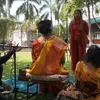How a group of students in Delhi are reviving dying artforms in India
Rivaayat is an initiative by the students of Shri Ram College of Commerce, Delhi, to revive the demand for dying arts and crafts like terracotta pottery.
For some years, the demand for Indian arts and crafts has been on a decline. Due to the increasing adaption of modern art into home décor and diversification of interests, the demand for classic wood sculptures, terracotta products, the weaves and wickers, among others, has been impacted.
In an attempt to refresh the demand for Indian arts and handicrafts, a group of students at Shri Ram College of Commerce, Delhi came together to start an initiative called Rivaayat on November 17, 2019.
The core team behind this initiative consists of Garv Vohra, Raya Dhawan, and Niladri Sekhar Mondal – who are the directors of Rivaayat.
“We came across a group of artisans selling very fine pottery products at very cheap rates. These products were valued at very high rates in the international and domestic markets, which made us think about the reason behind the same,” Garv tells SocialStory

The core team with their mentor Giriraj Prasad
After talking with the artisans, empathising with them, and earning their trust, the team came across Uttam Nagar in Delhi, which is the largest potters’ colony in India with over 600 artisan families.
After conducting various surveys and analysing the place, they realised that the artisans are not even earning Rs 5,000 per month, and the potters who practice fine pottery are shifting to raw pottery to cater to the festival demand and earn more.
“We found out that the direct market linkage is the major issue that these artisans are facing. Thus, we started Rivaayat to do something for these artisans and many more artisans like them under the mentorship of Shri Giriraj Prasad ji, who is a national awardee and an internationally recognised potter,” shares Niladri.
Reviving Indian arts
As new students enter college, they can also be a part of this initiative where the seniors teach the juniors about the operations.
Synonymous to traditions and legacy, Rivaayat was initially started with the motive to revive the long-lost art form of India – terracotta pottery.
“We have always emphasised on uplifting the handicraft sector of India which used to be our pride and, in the process, we're trying to revive the legacy of these long-lost artforms,” says Raya.
These terracotta pottery artisans are present in three states, namely Rajasthan, Delhi, and Haryana, having four artisans clusters in total.

Rivaayat aims to revive art like terracotta pottery
In addition, Rivaayat’s second venture, Water Hyacinth Basketry, launched in June 2021, is operating from a small village in Uttarakhand, called Khatima. Here, it is working with 50 tribal women artisans to provide them with a stable source of income. By the end of 2021, it also plans to support five more artforms to increase the impact.
“For the initial few months, we went to all major exhibitions in and around Delhi-NCR. But as the pandemic struck, we'd to shift to online means with no plans right then,” shares Niladri.
So, they collaborated with various e-commerce platforms and eventually, over the next nine months, the products were listed on 20+ platforms such as Amazon, Etsy, Gaatha, to name a few.
They also launched their own website on December 25, 2020 and started shipping across the globe from January 2021.
Impact on artisan lives
“Rivaayat has been associated with nearly 17+ artisans. We're now expanding to aid about 60+ artisans including tribal women as well. All this has been possible through the collective effort of our team and our zeal to impact the handicraft sector of India,” says Raya.
Ganga Sahay Prajapat, a terracotta artisan from Delhi, has been practising the art for the last 40 years. However, the demand for this product has been on a decline with the advent of technology that replaces terracotta. This led to difficult times for Ganga.
“With Rivaayat, I got a platform again to show my skills and showcase my artform to the world. Now, I have a sustainable income throughout the year and even more than that, now I can firmly believe that even after me, the art form will continue and will be immortal as it should be.” Ganga shares.

In the second phase, Rivayaat is looking to revive basket weaving.
Rakshita Janjire, one of the team members of Rivaayat, shares, “Rivaayat has taught me to think out of the box, work and persevere for communities in and around, and make the world a better place to live in. It has taught me much more than the course books.”
In terms of finances, the students of SRCC under the CDF-SRCC chapter initiated a crowdfunding campaign to manage the initial funds and presented at Dastakar Haat, Delhi with their mentor, Giriraj Prasad.
The project has been self-funded since then and run by the students who are the project stakeholders, and hasn’t received any other donations or investment.
“To provide aid to our artisans during tough times, we've even tried to get them registered under various government and non-government schemes and facilities,” says Garv.
Challenges and the way forward
In the initial phase of the research, it was really difficult for the team to convince the artisans to join them. However, they had to revamp the model and plan to address the challenges of the artisans.
“After managing the other aspects and launching the project, we did well for the first few months but again the pandemic proved to be a big hurdle, considering we're a social entrepreneurship model operating at a very small scale,” says Niladri.
“Moreover, just as we tried to expand our artform, the second wave struck and we'd to focus on online implementation. All these have been major hardships we've faced over our journey and as a team, we've stood strong and been able to tackle them all,” Raya adds.
For the road ahead, Rivaayat aspires to convert itself into a hub that undertakes multiple artforms under its umbrella with a singular goal to revive the dying art forms.
“We want to provide the masters of different arts, a platform to showcase their skills and connect to the modern-day markets. The main objective is to promote the handicraft sector of India which has always been its pride,” Garv signs off.
Edited by Kanishk Singh









